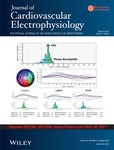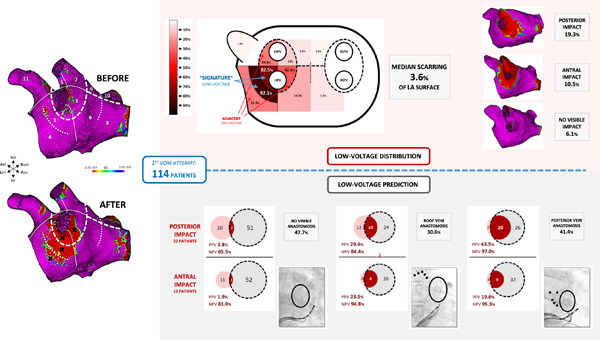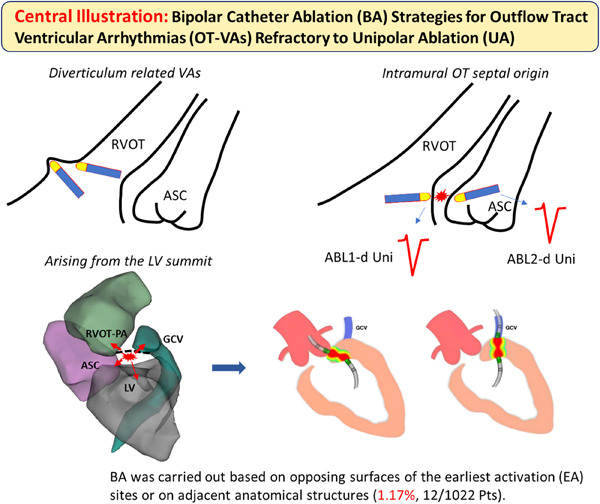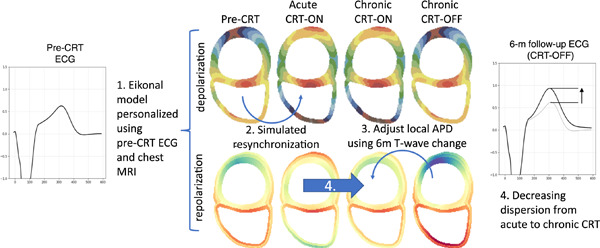Journal list menu
Export Citations
Download PDFs
COVER IMAGE
Cover Image, Volume 33, Issue 8
- Page: i
- First Published: 21 August 2022
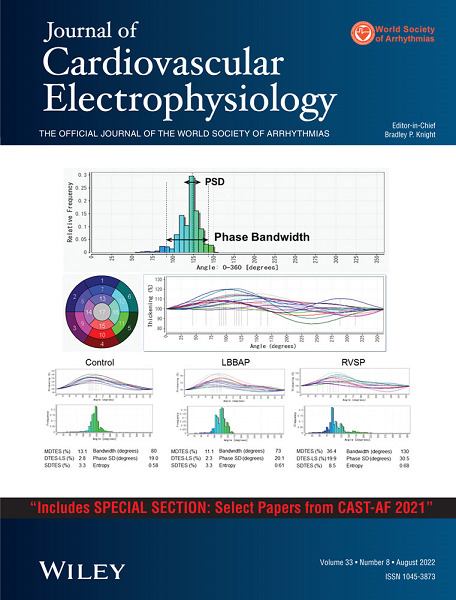
The cover image is based on the Research Article Assessing cardiac mechanical dyssynchrony in left bundle branch area pacing and right ventricular septal pacing using myocardial perfusion scintigraphy in the acute phase of pacemaker implantation by Keisuke Miyajima MD et al., https://doi.org/10.1111/jce.15609.
ISSUE INFORMATION
FEATURED ARTICLE
Automated detection of atrial fibrillation based on vocal features analysis
- Pages: 1647-1654
- First Published: 13 June 2022
ORIGINAL ARTICLES
ABLATION FOR ATRIAL FIBRILLATION
Durable pulmonary vein isolation with diffuse posterior left atrial ablation using low-flow, median power, short-duration strategy
- Pages: 1655-1664
- First Published: 22 May 2022
EDITORIAL
The wall of unintended consequences: Is the main benefit of posterior LA wall isolation simply more durable pulmonary vein isolation?
- Pages: 1665-1666
- First Published: 19 May 2022
ORIGINAL ARTICLES
ABLATION FOR ATRIAL FIBRILLATION
Posterior wall isolation in persistent atrial fibrillation feasibility, safety, durability, and efficacy
- Pages: 1667-1674
- First Published: 22 May 2022
- -
Acute isolation of the left atrial posterior wall in addition to PVI was swiftly achievable when recognizing the need for limited ablation in the center right zone (CRZ) in a third of patients.
- -
In contrast to PVI (85%) only 58% of ablated roof lines and 63% of inferior lines remained durably intact at 6 months mandatory reassessment.
- -
Despite limited chronic durability of posterior wall isolation, the median AF burden was 0.0% for 6 months using continuous heart rhythm monitoring (ICM)
EDITORIAL
Left atrial posterior wall isolation—The conundrum of safety versus efficacy
- Pages: 1675-1677
- First Published: 22 May 2022
ORIGINAL ARTICLES
ABLATION FOR ATRIAL FIBRILLATION
Stand-alone Focal Impulse and Rotor Modulation (FIRM) ablation versus second-generation cryoballoon pulmonary vein isolation for paroxysmal atrial fibrillation
- Pages: 1678-1686
- First Published: 26 May 2022
Distribution of atrial low voltage induced by vein of Marshall ethanol infusion
- Pages: 1687-1693
- First Published: 30 May 2022
EDITORIAL
The coronary sinus Marshall structure: From an anatomical ligament to an arrhythmogenic vein
- Pages: 1694-1696
- First Published: 30 May 2022
ORIGINAL ARTICLES
ABLATION FOR ATRIAL FIBRILLATION
Impact of left atrial low-voltage areas during initial ablation procedures on very late recurrence of atrial fibrillation
- Pages: 1697-1704
- First Published: 24 June 2022
Low left atrial appendage emptying velocity is a predictor of atrial fibrillation recurrence after catheter ablation
- Pages: 1705-1711
- First Published: 02 June 2022
EDITORIAL
Left atrial appendage emptying velocity as a predictor of recurrence of atrial fibrillation post-ablation
- Pages: 1712-1713
- First Published: 02 June 2022
ORIGINAL ARTICLES
ABLATION FOR ATRIAL FIBRILLATION
A comparison of clinical outcomes and cost of radiofrequency catheter ablation for atrial fibrillation with monitored anesthesia care versus general anesthesia
- Pages: 1714-1722
- First Published: 02 June 2022
EDITORIAL
ORIGINAL ARTICLES
ABLATION FOR ATRIAL FIBRILLATION
Assessment of the need of a waiting period after pulmonary vein isolation with the ablation index software
- Pages: 1725-1733
- First Published: 30 May 2022
EDITORIAL
Time to say good bye?—The value of a waiting period after pulmonary vein isolation
- Pages: 1734-1736
- First Published: 30 May 2022
ORIGINAL ARTICLES
ABLATION FOR ATRIAL FIBRILLATION
Patient-reported outcomes and costs associated with vascular closure and same-day discharge following atrial fibrillation ablation
- Pages: 1737-1744
- First Published: 22 May 2022
EDITORIAL
Can all stakeholders benefit from same-day discharge following catheter ablation of atrial fibrillation?
- Pages: 1745-1746
- First Published: 22 May 2022
ORIGINAL ARTICLES
ABLATION FOR ATRIAL FIBRILLATION
Transseptal puncture for left atrial ablation: Risk factors for cardiac tamponade and a proposed causative classification system
- Pages: 1747-1755
- First Published: 07 June 2022
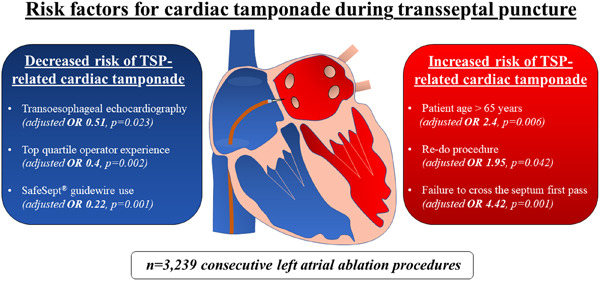
In this retrospective analysis of 3239 consecutive transseptal punctures performed during left atrial ablation, we present the independent risk factors for the occurrence of cardiac tamponade.
We also propose a novel classification system for the causes of cardiac tamponade during left atrial ablation.
EDITORIAL
Cardiac tamponade with transseptal puncture: Cross with care
- Page: 1756
- First Published: 07 June 2022
ORIGINAL ARTICLES
ABLATION BIOPHYSICS
Contact force guided radiofrequency current application at developing myocardium
- Pages: 1757-1766
- First Published: 16 May 2022
EDITORIAL
AMEN and ALARA—Remembering the dangers of the (new) technology of lesion formation
- Pages: 1767-1768
- First Published: 16 May 2022
ORIGINAL ARTICLES
ABLATION BIOPHYSICS
Bipolar catheter ablation strategies for outflow tract ventricular arrhythmias refractory to unipolar ablation
- Pages: 1769-1778
- First Published: 30 May 2022
EDITORIAL
Bipolar ablation for outflow tract ventricular arrhythmias: When the going gets tough, two catheters may be better than one
- Pages: 1779-1780
- First Published: 30 May 2022
ORIGINAL ARTICLES
LAA CLOSURE
Novel computed tomography angiography-based sizing methodology for WATCHMAN FLX device in left atrial appendage closure
- Pages: 1781-1787
- First Published: 18 May 2022
EDITORIAL
Seize the day, …s(e)ize the device: The emerging imaging modality to improve left atrial appendage device sizing
- Pages: 1788-1790
- First Published: 18 May 2022
ORIGINAL ARTICLES
ABLATION FOR VT
Temporal and spatial pacemap parameters for identification of cardiac surfaces with critical sites for ventricular tachycardia
- Pages: 1791-1800
- First Published: 24 June 2022
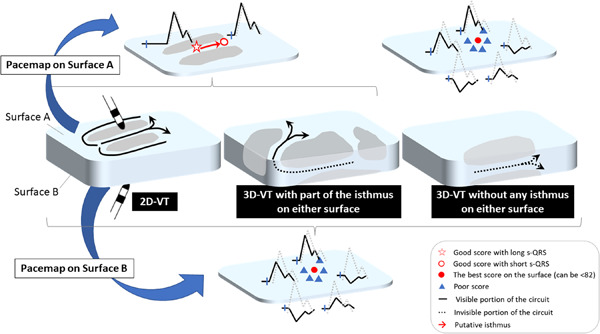
Pacemap conducted on the surfaces harboring isthmus demonstrate sites showing good pacemap scores with a long and a short pacing latency (temporal distribtion), in a separate location (spatial distribution), enabling to delineate the putataive isthmus, regardless of whether the entire circuit is on the surface or not.
Pacemapping conducted on the surfaces not harboring isthmus demonstrate only modest pacemap scores, surrounded by poorer score.
How to use pace mapping for ventricular tachycardia ablation in postinfarct patients
- Pages: 1801-1809
- First Published: 06 June 2022
EDITORIAL
High-density pace-mapping for scar-related ventricular tachycardia ablation
- Pages: 1810-1812
- First Published: 06 June 2022
ORIGINAL ARTICLES
CARDIAC PACING AND DEFIBRILLATION
Implantable cardioverter defibrillators in patients with orthotopic heart transplant: A multicenter case series
- Pages: 1813-1822
- First Published: 07 June 2022
EDITORIAL
Defibrillators in heart transplant patients: Not always a shockingly good choice
- Pages: 1823-1825
- First Published: 07 June 2022
ORIGINAL ARTICLES
CARDIAC PACING AND DEFIBRILLATION
Assessing cardiac mechanical dyssynchrony in left bundle branch area pacing and right ventricular septal pacing using myocardial perfusion scintigraphy in the acute phase of pacemaker implantation
- Pages: 1826-1836
- First Published: 24 June 2022
Synchronization of repolarization after cardiac resynchronization therapy: A combined clinical and modeling study
- Pages: 1837-1846
- First Published: 03 June 2022
Factors related to the skin thickness of cardiovascular implantable electronic device pockets
- Pages: 1847-1856
- First Published: 27 June 2022
EDITORIAL
Risk of skin erosion and local pocket infections in population of patients with cardiac implantable electronic devices undergoing transvenous lead extraction
- Pages: 1857-1862
- First Published: 27 June 2022
ORIGINAL ARTICLES
SYNCOPE
Implementation of supervised physical training to reduce vasovagal syncope recurrence: A randomized controlled trial
- Pages: 1863-1870
- First Published: 30 May 2022
EDITORIAL
Treating syncope without drugs: Standing still, exercising hard, or simply the “expert's touch”?
- Pages: 1871-1873
- First Published: 30 May 2022
ORIGINAL ARTICLES
BRUGADA SYNDROME AND VACCINATIONS
Fever following Covid-19 vaccination in subjects with Brugada syndrome: Incidence and management
- Pages: 1874-1879
- First Published: 13 June 2022
EDITORIAL
STEP-BY-STEP SERIES
Amplatzer Amulet™ left atrial appendage occluder: A step-by-step guide to device implantation
- Pages: 1881-1887
- First Published: 17 February 2022
BRIEF COMMUNICATION
M-beat—A novel marker for selective left bundle branch capture
- Pages: 1888-1892
- First Published: 13 June 2022
EP ROUNDS
Wide QRS complex tachycardia mechanism discovered through the analysis of the cardiac resynchronization therapy-defibrillator intracardiac electrogram
- Pages: 1893-1896
- First Published: 16 June 2022
CASE REPORTS
Transient left phrenic nerve paralysis after ethanol infusion into the vein of Marshall
- Pages: 1897-1900
- First Published: 13 June 2022
Occult arterial bleeding associated with cardiac device implantation
- Pages: 1901-1904
- First Published: 29 June 2022
Distinct propagation patterns of right pulmonary veins through multiple epicardial connections during right atrial pacing and sinus rhythm
- Pages: 1905-1907
- First Published: 01 July 2022
LETTERS TO THE EDITOR
Positive QRS complex in limb lead 2 with negative QRS in lead 3 on surface electrocardiogram is not indicative of a right sided accessory pathway
- Page: 1908
- First Published: 16 June 2022
REPLY
Inferior lead QRS discordance on surface electrocardiogram predicting right anterior accessory pathways: A simplified approach
- Pages: 1909-1910
- First Published: 16 June 2022
SPECIAL SECTION: CAST-AF 2021
INVITED REVIEWS
The future of long-term monitoring after catheter and surgical ablation for atrial fibrillation
- Pages: 1911-1918
- First Published: 20 January 2022
The Convergent procedure for AF: A surgeon's perspective
- Pages: 1919-1926
- First Published: 07 February 2022
Transseptal access: A review of contemporary tools
- Pages: 1927-1931
- First Published: 28 February 2022
Genetically based atrial fibrillation: Current considerations for diagnosis and management
- Pages: 1944-1953
- First Published: 09 March 2022
The hybrid convergent procedure for persistent and long-standing persistent atrial fibrillation from an electrophysiologist's perspective
- Pages: 1954-1960
- First Published: 14 April 2022
Staged hybrid totally thoracoscopic maze and catheter ablation for atrial fibrillation
- Pages: 1961-1965
- First Published: 13 June 2022
A history of collaboration between electrophysiologists and arrhythmia surgeons
- Pages: 1966-1977
- First Published: 13 June 2022
Reducing permanent pacemaker requirements following concomitant surgery for atrial fibrillation
- Pages: 1978-1982
- First Published: 23 July 2022




